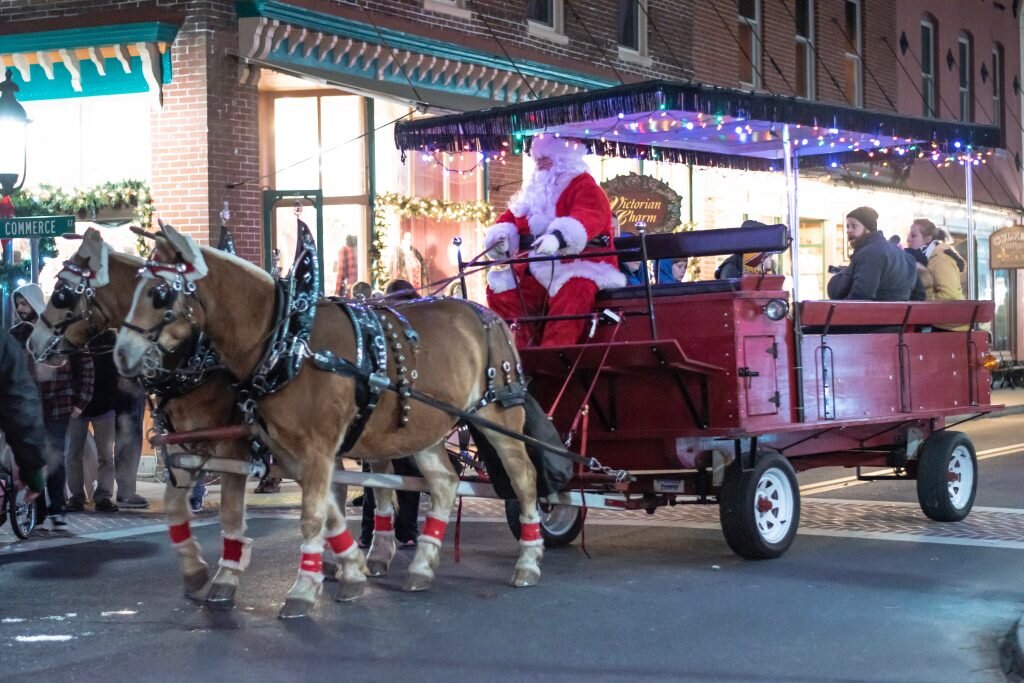
JOSH DAVIS/BAYSIDE GAZETTE
Santa Claus himself offered reindeer-drawn sleigh rides through the Town of Berlin during a packed holiday event last Friday. The event drew thousands of spectators, and offered a golden opportunity for officials conducting a parking study to see firsthand the stresses on available parking.
By Josh Davis, Associate Editor
(Nov. 29, 2018) Berlin Main Street was exceptionally busy during a Christmas tree-lighting ceremony and launch of the holiday season last Friday.
Along with the towering tree, placed just off the porch of the Atlantic Hotel, thousands of people were visiting shops and restaurants, taking free reindeer-drawn sleigh rides with Santa Claus, and ordering hot chocolate and other seasonal treats from the food vendors downtown.
Many families with small children were there, but also witnessing the spectacle were representatives from Sabra & Associates Inc., a Columbia, Maryland firm hired by the Town of Berlin last month to oversee a multiphase parking study.
Berlin Mayor Gee Williams on Monday spoke with Project Manager Brian Laverty about what he and his team had witnessed. Laverty was in town on Nov. 15 and 16, and two of his associates collected more data last Friday and Saturday.
Williams said while parking during events was expected to be a problem, “It’s one thing to know of it, but it’s another to actually see what’s happening, and it makes quite an impression.”
From where he was standing, on the balcony of the Atlantic Hotel to oversee the tree lighting and to flip the switch on the downtown lights, Williams said the Friday night crowd appeared to be the largest yet.
“My general impression was it was the largest crowd we had so far, and I was pleased, because it was obviously the coldest tree lighting that I can remember,” Williams said. “The turnout exceeded my expectations.”
According to Williams, Laverty’s biggest takeaway away was that parking for downtown workers “is a bigger part of our problem than he had anticipated.”
“His first major impression is that we don’t have enough parking for employees,” Williams said. “If we had more parking for employees, than we’d have a lot more parking for everyone else. And, of course, with more businesses in downtown Berlin than there’s ever been, there’s naturally more employees.”
Also discussed was improving access for public safety vehicles and equipment in the neighborhoods that surround Main Street.
“That’s something we never used to have to think about, but that’s another thing they’re looking into,” Williams said.
Sabra is expected to deliver a technical report in January with some initial findings. Additional work on phase one of the study will be done next summer, Williams said.
“That way they have a complete picture,” he said. “As a coastal community, it’s very obvious we have a significant impact from the tourism that’s created from the summer and the shoulder months.”
With attendance for the tree lighting so great, there’s evidence that parking problems in downtown Berlin are only getting tougher to address.
“It’s certainly one of the issues we want to address and see what can be done in the short term – and what must be done in the longer view,” Williams said. “Once this phase one is done, in the summer, I’ve asked them [to include] what recommendations and what follow-up [is necessary], so that we can budget a phase two of the study.
“Obviously, I think it would be wise to know what that cost would be, so that we can budget it this spring for implementation in the next fiscal year, so we don’t lose the momentum and we continue to move along in this project,” he added.
As for what can be done, Williams said he’s keeping an open mind.
“Obviously, like everybody else I do have a few viewpoints based on experience,” he said. “I would say, in general, that it’s a seasonal situation that peaks from midsummer to early fall, and then has a sort of second wave during the period from Thanksgiving through New Year’s.”
January, February and March are generally slower periods, while April and May are transition months, Williams said.
“The idea is [figuring out] what do we need to do,” he said. “Public safety is obviously number one, but there’s also convenience. We want to be a community where people can come regardless of age, and be very mobile for children and parents, grownup children like myself, and then for older folks.
“I think looking at this is worth our time in our community’s development, and thank goodness we can make preparations,” Williams continued. “It’s very important that … whatever we do with traffic and mobility compliments our historic community, but does not diminish it.
“We’re not planning or anticipating trying to expotentially increase our demand for parking in this town, but I think we now have enough experience to know that we need to have strategies and some practical plans in place so that, as the town does continue to develop in terms of its tourism, we won’t be sitting there wondering what we should do. We should be preparing for the future – not reacting to it,” Williams said.
